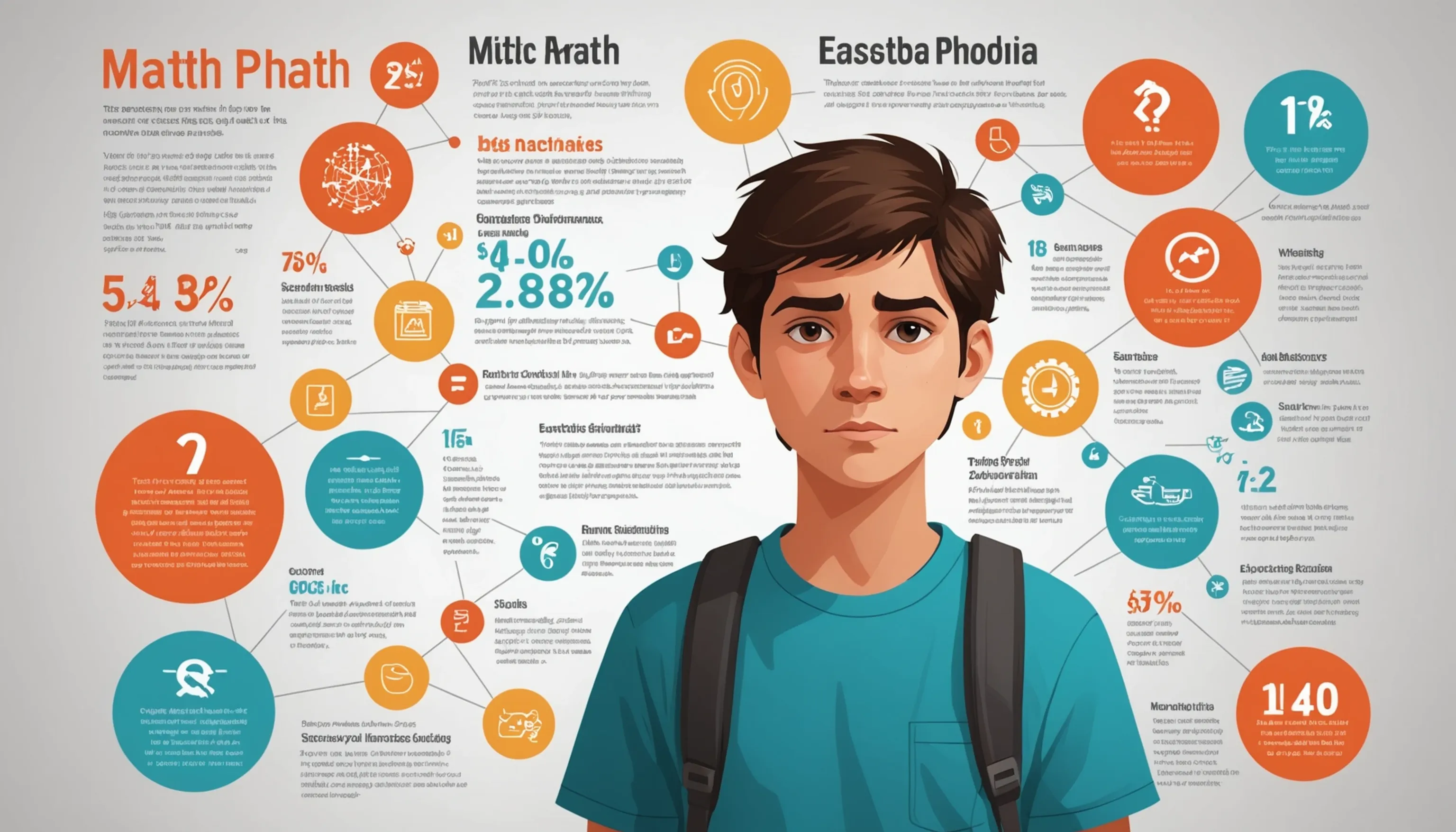Heal Math Phobia in Teenagers
 HvWHenry van Wagenberg
HvWHenry van Wagenberg
Understanding Math Phobia in Teenagers
Math phobia is a common issue among teenagers, manifesting as a significant fear or anxiety towards mathematics. This condition can severely impact their academic performance and self-esteem. Teenagers with math phobia often experience feelings of dread before math classes or tests, leading to avoidance behaviors.
Understanding this phobia is crucial for parents and teachers, as it can stem from various factors, including negative experiences in math, societal pressures, or a lack of confidence. By recognizing these signs early, supportive strategies can be implemented to help teenagers overcome their fear and develop a more positive attitude towards math.
What is Math Phobia?
Math phobia is defined as an intense fear or anxiety associated with mathematics. This fear can be so overwhelming that it prevents individuals, particularly teenagers, from engaging in math-related activities. It is important to note that math phobia is not merely a dislike of math; it is a psychological condition that can lead to avoidance behaviors and even physical symptoms such as sweating, rapid heartbeat, or nausea when confronted with math tasks.
Many teenagers develop math phobia due to negative experiences in their early education. These experiences can include:
- Negative feedback: Harsh criticism from teachers or parents can create a lasting fear of failure.
- Peer pressure: Comparisons with peers can foster feelings of inadequacy, leading to anxiety.
- Societal stereotypes: Cultural beliefs that suggest math is inherently difficult or that only certain people can excel in it contribute to a negative mindset.
In addition, the pressure to perform well in standardized testing can exacerbate feelings of anxiety. Teenagers may feel that their self-worth is tied to their math performance, making them more susceptible to math phobia.
Understanding math phobia is the first step toward addressing it. By recognizing the symptoms and underlying causes, parents and educators can provide the necessary support to help teenagers overcome their fear, fostering a healthier relationship with mathematics.
Signs and Symptoms of Math Phobia
Recognizing the signs and symptoms of math phobia in teenagers is essential for providing timely support. These symptoms can manifest both emotionally and physically, affecting their overall well-being and academic performance.
Common signs include:
- Intense anxiety: A teenager may experience overwhelming fear when faced with math tasks, leading to panic attacks or avoidance behaviors.
- Physical reactions: Symptoms such as sweating, rapid heartbeat, nausea, or even headaches may occur during math classes or tests.
- Negative self-talk: Teens with math phobia often express feelings of inadequacy, using phrases like "I'm just not good at math" or "I'll never understand it." This negative mindset can further entrench their fear.
- Avoidance behaviors: They may skip math classes, procrastinate on assignments, or refuse to participate in group activities that involve math.
Additionally, math phobia can lead to a decline in overall academic performance. Students may struggle with grades, leading to a cycle of negative reinforcement. Parents and teachers might notice:
- Declining grades: A drop in math performance, often accompanied by increased stress.
- Changes in attitude: A previously enthusiastic student may become disengaged or frustrated with learning.
Being aware of these signs enables parents and educators to intervene early. Providing support, understanding, and resources can help teenagers overcome their math phobia, ultimately improving their confidence and performance in mathematics.

Causes of Math Phobia in Teenagers
The causes of math phobia in teenagers are multifaceted and can stem from various psychological, social, and educational factors. Understanding these causes is crucial for parents and educators who aim to help students overcome their fears.
One primary cause is negative early experiences with math. If a teenager struggles in math during their formative years, they may internalize the belief that they are incapable of understanding the subject. These negative experiences can arise from:
- Poor teaching methods: Ineffective instruction can leave students confused and frustrated, leading to a lasting aversion to math.
- Critical feedback: Harsh criticism from teachers or peers can damage a teenager's self-esteem and reinforce the idea that they will never succeed in math.
Additionally, societal pressure plays a significant role in math phobia. Stereotypes suggesting that certain groups are naturally better at math can foster feelings of inadequacy in those who do not fit these stereotypes. Furthermore, the pressure to perform well on standardized tests can create an overwhelming fear of failure.
Another contributing factor is the lack of real-life application in math education. When teenagers fail to see how math relates to their everyday lives, they may become disinterested, leading to anxiety when confronted with the subject.
By identifying these causes, parents and educators can implement strategies to mitigate math phobia, fostering a more positive learning environment that encourages growth and confidence in mathematics.
Strategies to Heal Math Phobia
Healing math phobia involves implementing effective strategies that foster a positive attitude toward mathematics. First, create a supportive learning environment where mistakes are viewed as opportunities for growth. Encourage open dialogue about math-related fears to validate feelings.
Using real-life applications can help students see the relevance of math in everyday situations, making the subject more approachable. Additionally, promote a growth mindset by praising effort rather than innate ability, reinforcing the idea that skills can be developed over time.
Finally, incorporate engaging math games and activities to make learning enjoyable and reduce anxiety.
Creating a Positive Learning Environment
Creating a positive learning environment is essential for helping teenagers overcome math phobia. A supportive atmosphere encourages students to engage with math without fear of judgment, fostering a love for learning.
First, establish clear communication where students feel comfortable sharing their struggles with math. Encourage them to ask questions and express their feelings about the subject. Regularly check in with students to gauge their comfort levels and adjust your teaching methods accordingly.
Next, emphasize a growth mindset. Teach students that intelligence and math skills can be developed through practice and perseverance. Celebrate small victories and progress rather than focusing solely on grades. Acknowledge their efforts, reinforcing the idea that making mistakes is part of the learning process.
Incorporate collaborative learning experiences. Group work can help reduce anxiety, as students can share their thoughts and strategies in a low-pressure setting. Peer support allows them to learn from one another and realize they are not alone in their challenges.
Utilizing multisensory teaching methods can also enhance engagement. Incorporate visual aids, hands-on activities, and technology to make math concepts more accessible and enjoyable.
Finally, ensure that the classroom atmosphere is welcoming and inclusive. Display positive affirmations and visuals that celebrate diversity in mathematical abilities, reinforcing the idea that everyone can succeed in math with the right support and mindset.

Using Real-Life Applications of Math
Using real-life applications of math is an effective strategy to help teenagers overcome math phobia. When students can see the practical relevance of math in their daily lives, it becomes less intimidating and more engaging.
Start by integrating math concepts into everyday scenarios. For example, while cooking, discuss measurements, proportions, and conversions. This hands-on experience allows students to apply their math skills in a familiar context, reinforcing the idea that math is not just abstract but a useful tool.
Incorporate activities that involve budgeting or financial planning. Ask students to create a budget for a hypothetical event, such as a birthday party or a school trip. This exercise teaches them about addition, subtraction, and percentages while demonstrating the importance of math in managing finances.
Additionally, use sports statistics to illustrate mathematical concepts. Analyze players' performance data to teach averages, percentages, and ratios. This approach connects math to their interests and hobbies, making the subject more relatable.
Encourage students to explore technology and data analysis. Use apps or software that involve math, such as video game design or coding. This not only showcases the application of math but also aligns with current trends and careers, making it more appealing.
By incorporating real-life applications, educators can demystify math and help students develop confidence in their abilities. This approach fosters a positive attitude toward math, ultimately reducing anxiety and promoting a lifelong appreciation for the subject.
Encouraging a Growth Mindset
Encouraging a growth mindset is a powerful strategy to help teenagers overcome math phobia. A growth mindset is the belief that abilities and intelligence can be developed through dedication, effort, and learning from mistakes. This perspective fosters resilience and a love for learning.
To promote a growth mindset in the math classroom, start by emphasizing the importance of effort over innate ability. Share stories of successful individuals who faced challenges and learned from their failures. Highlight how persistence and hard work can lead to improvement in math skills.
Provide constructive feedback that focuses on specific strategies for improvement. Instead of simply praising correct answers, acknowledge the problem-solving process. For example, say, “I really appreciate how you approached that problem. Let’s explore why your method worked or didn’t work.” This reinforces the idea that understanding the process is just as valuable as finding the right answer.
Introduce challenges that are slightly above the students’ current level. This encourages them to stretch their abilities without causing undue frustration. Celebrate their progress and breakthroughs, no matter how small, to build their confidence.
Incorporate reflective practices, such as journaling or group discussions, where students can share their learning experiences and setbacks. This normalizes challenges and helps them see that others face similar struggles.
By fostering a growth mindset, educators can empower teenagers to approach math with curiosity and resilience, ultimately reducing anxiety and helping them build a more positive relationship with the subject.
Resources for Parents and Teachers
Providing effective resources for parents and teachers is crucial in helping teenagers overcome math phobia. Numerous books and online platforms can offer valuable insights and strategies.
Books such as "The Math Myth" by Andrew Hacker and "Mindset: The New Psychology of Success" by Carol S. Dweck delve into the psychology of learning and offer practical advice on fostering a positive attitude towards math.
Online courses like those available on platforms such as Khan Academy and Coursera provide engaging math tutorials tailored for different learning levels. These resources allow students to learn at their own pace, building confidence along the way.
Additionally, math games and apps like Prodigy and Mathletics can make learning enjoyable and interactive. These tools not only reinforce math skills but also create a fun environment that reduces anxiety.
By utilizing these resources, parents and teachers can effectively support students on their journey to overcoming math phobia.
Books and Online Courses
Books and online courses are invaluable resources for parents and teachers looking to help teenagers overcome math phobia. Several well-regarded books provide insights into the psychology of learning mathematics, offering practical strategies to foster a positive mindset.
One highly recommended book is The Math Myth by Andrew Hacker. This book challenges traditional views on mathematics education and discusses the societal implications of math anxiety. It provides alternative perspectives that can help educators and parents understand the root causes of math phobia.
Another essential read is Mindset: The New Psychology of Success by Carol S. Dweck. This book emphasizes the importance of a growth mindset, illustrating how believing in the ability to learn can transform students' approach to challenges, including math.
In terms of online courses, platforms like Khan Academy offer free, comprehensive math resources, including instructional videos and practice exercises tailored to different skill levels. This allows students to progress at their own pace, reinforcing their learning and building confidence.
Additionally, websites like Coursera provide access to courses from prestigious universities, covering various aspects of mathematics and learning strategies. These courses can guide parents and teachers in implementing effective techniques to support students.
By utilizing these books and online resources, parents and teachers can equip themselves with the knowledge and tools necessary to help teenagers navigate their math-related fears and develop a positive relationship with the subject.
Math Games and Apps
Incorporating math games and apps into learning can significantly help teenagers overcome math phobia by making math engaging and enjoyable. These tools provide interactive experiences that can transform the way students perceive and interact with mathematics.
One popular app is Prodigy Math, which turns math practice into an adventure game. Students create their own characters and solve math problems to progress through levels and earn rewards. This gamified approach encourages a positive attitude toward math while reinforcing essential skills in a fun context.
Another excellent resource is Mathletics, which offers a comprehensive suite of math activities aligned with curriculum standards. It adapts to each student's learning pace, providing personalized feedback and challenges that boost confidence and competence.
Apps like Sumdog also focus on collaborative learning. By connecting students with peers, it fosters a supportive environment where they can compete and collaborate, reducing anxiety and promoting teamwork.
Furthermore, platforms like Kahoot! allow teachers to create interactive quizzes that engage students in a competitive format. This approach can make reviewing math concepts more dynamic and less intimidating.
By leveraging these math games and apps, parents and teachers can create a more enjoyable learning experience, helping teenagers build confidence and reduce their fear of math while developing crucial skills in the process.
